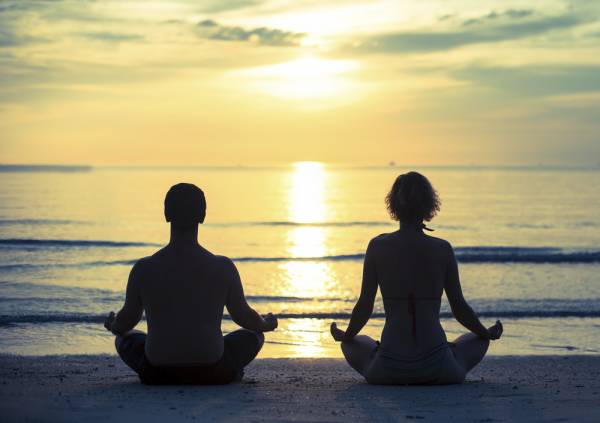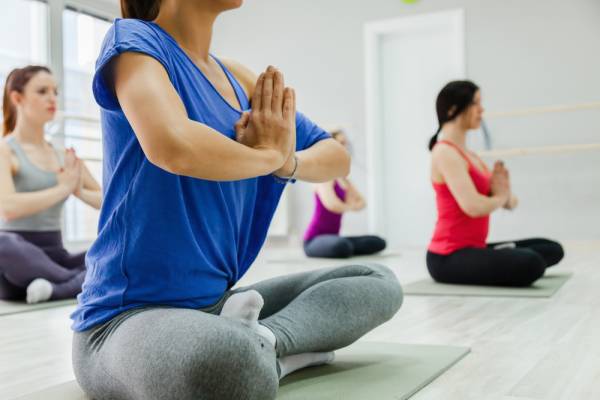With the exception of a few subcultures, the western way slants heavily toward what the eastern yogic traditions would label gross (or physical) level awareness. From the time we’re born, we are educated to relate to ourselves primarily as a physical being.
Looking Beyond the Microscope
The visible, so-called tangible stuff that can be measured and seen through microscopes is most valued and valid. Many of you reading this right now are probably thinking, “Well, yeah of course it is, duh!” But there’s more, a lot more.
And the “more” is essential to our mental and physical well-being. Modern systems are coming to the same conclusions the ancients did thousands of years ago. The revelations of quantum physics show that matter and energy behave differently at the quantum level than our everyday perceptions would have us believe. The field of medicine is recognizing the mind-body connection and the effect of thought and belief on the physical body.
“As modern science has done a thorough job of mapping the physical body, so has ancient wisdom done an equally thorough job of mapping the subtle body.”
More and more we’re finding that real health (wholeness) depends on developing a relationship with the deeper aspects of ourselves. So the information below is far more than metaphorical. As counterintuitive as it might be to the modern mind, it has very practical ramifications.
Anatomy in a western context is about physicality. But according to yoga, anatomy also includes energy and subtle body systems. As the eastern practice of Hatha Yoga, has been integrated into the western world, this aspect of its teachings has been largely overlooked.
RELATED: What All Athletes Can Learn From the Life of B.K.S. Iyengar
After fifteen years of practicing yoga and six years of teaching, I’m just beginning to recognize the importance of yogic anatomy. To understand alignment from a physical perspective is one thing, but to understand energy or the subtle body is another.
The Mechanisms of Mindfulness
Delving into the main guidebooks for Hatha Yoga (Hatha Yoga Pradipika, Gheranda Samhita, Siva Samhita, andYoga Sutras of Patanjali), we find the teachings weighing heavily towards the more subtle realms of our being – states of consciousness and meditation. Postures are secondary. In fact, of the combined fifty or so poses that are mentioned in the above texts, all are simple seated postures.
“Modern systems are coming to the same conclusions the ancients did thousands of years ago. The revelations of quantum physics show that matter and energy behave differently at the quantum level than our everyday perceptions would have us believe.”
If the great sages were more concerned with the subtle realms of anatomy, shouldn’t we also be at least somewhat interested, if not highly eager to learn about them? As modern science has done a thorough job of mapping the physical body, so has ancient wisdom done an equally thorough job of mapping the subtle body.
Here is a brief overview of the five main facets of yogic anatomy. Keep in mind these are simplistic descriptions. Entire books and numerous articles have been written about each one.

TRY THIS: 5 Simple Tips To Start a Meditation Practice
Prana
This word is most commonly translated as “life-force.” Though we’re simplistically taught to think of prana as synonymous with breath, it really isn’t. Prana describes the life-giving force of all things (“chi” in Chinese and Japanese systems), and breath is an expression of that. Breath is one of the most tangible ways to feel this invisible power.
Vayus
Vayu means “wind.” It’s root, “va” means “that which flows.” Vayus describe the way prana moves within the body. There are five major vayus (49 total), all of which function simultaneously while individually governing specific areas of the body, such as digestion, respiration, and speech. By understanding their functions, we can bring conscious control to the body-mind through the practice of yoga.
Nadis
Meaning “tube or pipe,” nadis are invisible channels that carry prana throughout the body. You might say they do for energy what veins do for blood. They are sensed, felt, and seen, through inner vision. Out of 72,000 nadis, three are thought to be most important.
- Sushumna runs along the spine from base to crown carrying kundalini energy (latent spiritual power) up the spine.
- Ida nadi runs along the left side of the sushumna and relates to the moon or passive, cooling, feminine energy.
- Pingala is the solar channel that runs along the right side of the sushumna. It represents warmth, governs activity, and masculine elements of personality.
“Teachers with integrity have to take it upon themselves to learn and embody more so our students can get the full benefits of the science of yoga.”
Chakras
These are the wheels of energy or spiritual power located along the nadis. Hatha Yoga texts name seven. Each one has a symbol, vibration, color, and sound related to it. Chakras are said to move in a spinning motion and each one governs different aspects of our psyches.
Koshas
These are the energy layers or sheaths that represent the various aspects of our being. Starting outward and going to the innermost core, there are five main koshas – annamaya (physical), pranamaya (pranic or energy), manomaya (mind, emotions, nervous system), vijanamaya (wisdom), anandamaya (bliss).
Aim for a Holistic Approach to Yoga
Because of the heavy emphasis on asana in modern day yoga, the basic 200-hour teacher trainings barely (if at all) touch on yogic anatomy. Yoga Alliance standards, at the 200- and 300-hour levels, lump “energy anatomy” in with the required hours for “Anatomy and Physiology.” As a result, the education on the subtle body is often left out due to practical necessity.
“To understand alignment from a physical perspective is one thing, but to understand energy or the subtle body is another.”
With the physical so heavily emphasized in our culture, teachers do need to be trained in alignment to accommodate that. But that leaves very few teachers who have the skill to incorporate these other elements with any level of understanding. As a student having experienced the subtler aspects of yoga, it’s hard to imagine people not getting these benefits – or at least the exposure to them, so they have a choice.
RELATED: What Is Yoga, Really? An Interview With Arvind Chittumalla
Yoga students reading this, if it intrigues you, seek out teachers who are offering a holistic understanding of yoga. This is where the dots start to connect and yoga becomes as much a work-in as a work-out. Then the lessons begin to follow us off the mat and into our lives.

As the masterful bridge-builder between western and yogic anatomy Leslie Kaminoff put it in his book, Yoga Anatomy, “Once there, we will not only understand our anatomy but also directly experience the reality that gives rise to the core concepts of yoga. This is a truly embodied experience of spirituality.”
Be a Teacher and a Student
Teachers with integrity have to take it upon themselves to learn and embody more so our students can get the full benefits of the science of yoga. As master teacher TKV Desikachar so aptly put it, “The success of Yoga does not lie in the ability to perform postures but in how it positively changes the way we live our life and our relationships.” We need all of yoga to lead a yogic life.
1. “Prana Vayu – Five vital forces.” Last modified July, 2008.
2. Reece, Andrew G.,The Big Book of Yoga.
3. Bailey, James, “Discover the Ida and Pingala Nadis.”
4. Anodea, Judith, Eastern Body, Western Mind: Psychology and the Chakra System as a Path to the Self. Celestial Arts, 2004.
5. Stiles, Mukunda, Yoga Sutras of Patanjali. Weiser Books, 2001.
6. Rai Bahadur Srisa Chandra Vasu, The Gheranda Samhita. Munshirm Manoharlal, 1996.
7. Mallinson, James, The Shiva Samhita. YogaVidya.com, 2007.
Photos courtesy of Shutterstock.






